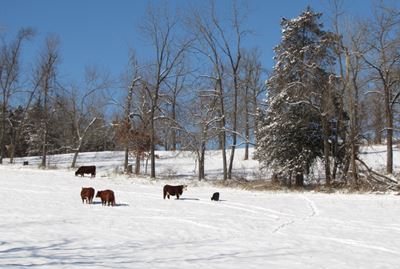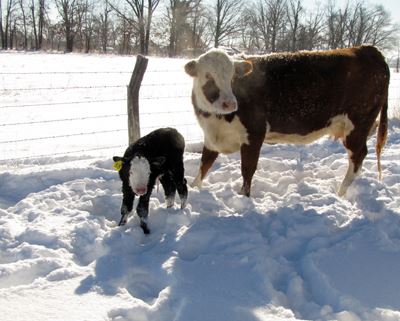|
Winter Means Cattle Producers Need To Keep Closer Eye On Herds
Cattle’s Caloric Needs Rise In Cold Weather, Provide High Quality Hay
LITTLE ROCK, ARK.
Mother Nature is taking the gloves off this week, delivering Arkansas a one-two punch of arctic cold and precipitation, and Arkansas’ cattle producers need to be on high alert.
A winter storm warning was in effect from 6 p.m. Thursday to 6 p.m. Friday for Benton, Carroll, Cleburne, Conway, Faulkner, Garland, Independence, Jackson, Logan, Lonoke, Madison, Monroe, Montgomery, Perry, Polk, Prairie, Pulaski, Saline, Scott, Washington, White, Woodruff and Yell counties.
Ice storm warnings were in effect for Crawford, Franklin and Sebastian counties until 6 p.m. Friday.
“Cattle are generally fine in the cold weather,” said Shane Gadberry, associate professor for the University of Arkansas System Division of Agriculture. “However, when the weather turns wet, the situation changes.”

Cattle out in the snow in this 2011 file photo taken in Boone Co., Ark.
U of Arkansas System Division of Agriculture photos by Nita Cooper

Cow and calf in the snow in this 2011 file photo taken in Boone Co., Ark.
Gadberry recommends that ranchers:
• Provide shelter. “Cows with a normal winter coat cope well with temperatures as low as 32 degrees and much lower for breeds that grow a heavy hair coat,” he said. “However, a wet coat increases a cow’s lower critical temperature to near 60 degrees.” The wind chill factor is important as well. “Cattle producers aren’t set up to keep cattle from getting wet during winter, however, windbreaks which reduce wind chills are beneficial. Move cattle where they can easily access natural or manmade windbreaks,” Gadberry said.
• Feed higher quality hay. When it’s cold, cattle need more calories to keep warm. Hay that’s high in protein and total digestible nutrients will provide more energy to cows. Gadberry said that during winter, a cow’s food intake can increase 5 to 10 percent. “Make sure cows have free choice access to hay,” he said. “For personal safety, put out several days worth of hay to minimize the amount of travel on icy roadways, and account for higher intakes when estimating how much hay to make available.”
• Keep water available. Water intake and feed intake are related. If cattle can’t drink, this will affect their food intake and ability to cope with winter weather.
• Watch for mud after the thaw. Muddy conditions can affect food intake. When mud is widespread and thick around feeding stations, “food intake can be reduced by as much as 15 to 30 percent,” Gadberry said. Make sure feeding sites are well drained, watch cattle feeding behavior to determine the difficulty in accessing the hay ring or feed bunk, and relocate feeding areas if mud becomes an issue.
For more tips on winter-feeding of cattle, see Gadberry’s full article at http://arkansaslivestockdotcom.wordpress.com/2013/12/05/a-few-reminders-for-arkansas-cattle-producers-facing-their-first-winter-weather-threat-of-the-2013-14-season/ or contact your local county extension office.∆
|
|